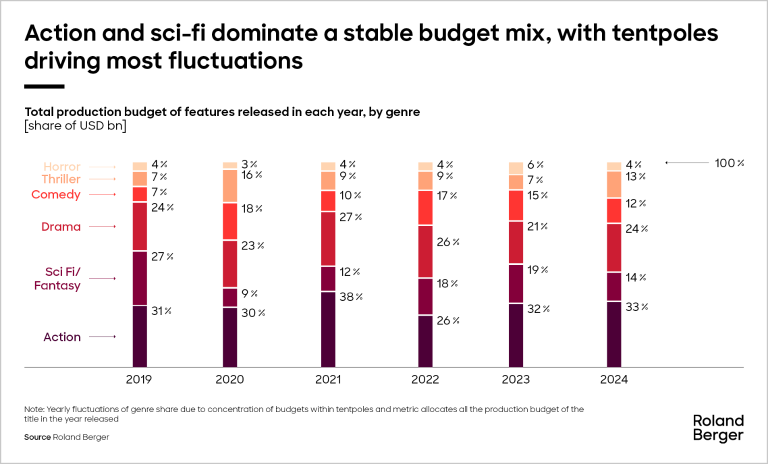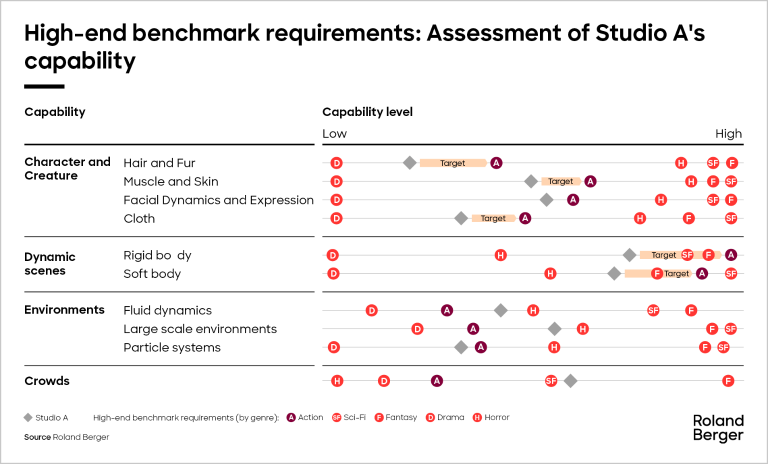Discover how AI is revolutionizing visual affects and animation with cost-effective solutions like automated rotoscoping and image enhancement for maximum ROI


How to prioritize investment in visual effects simulation capabilities
Target areas and a structured approach to leverage your strengths
Simulation capabilities are critical to the success of VFX houses. But in a changing industry environment, too many are failing to adapt to the new realities of constrained production budgets and shifting preferences, meaning they miss out on new opportunities. By specializing in niche simulation areas, such as characters, dynamic scenes or crowds, studios can better showcase their skills, enhance their bid-win rates and attract the best talent. Here we assess some of the most promising areas within feature film genres and outline a structured approach to ensure investments in capabilities are effective and operationally aligned.

"Strong simulation capabilities are essential to compete, studios must deliver quality fast and be honest about where they need to improve"
The VFX landscape is undergoing a transformation. Streaming platforms now account for an ever-growing proportion of production budgets, while traditional studios find themselves under intense financial pressure to deliver content more cost-effectively. At the same time, franchise fatigue, underperforming fundamentals and writers’ strikes are weighing on the industry.
VFX houses need to adapt to these challenges by developing more efficient pipelines. However, development requires cautious consideration before investment. This could mean addressing debt or simply getting back to the VFX Reference Platform for the latest tools. But, most importantly, it should mean focusing on upgrading simulation capabilities.
Specialization, be it in characters, dynamic scenes or crowds, is a key competitive differentiator and brings significant rewards. Studios that excel in niche simulation work often secure high-quality, big budget productions. Another advantage lies in the caliber of talent this work attracts, with big-budget productions drawing highly skilled artists. By focusing on genre-specific simulation expertise, studios can not only enhance their bid-win rates but also establish themselves as go-to specialists for certain types of VFX work.
But upgrading specialization capabilities takes time and money. If you want to level up your capabilities, where should you invest your time and money? This article identifies the most promising specializations in feature film genres, from sci-fi to period drama, and outlines a structured commercial approach to ensure success in the new VFX landscape. In particular, it highlights that studios must be proactive in developing a specialization rather than reactive.
"Studios that align simulation investments will win the next wave of high-value projects. Specialization is not optional; it is the fastest path to relevance, reputation and revenue."
Why simulation capabilities – and specialization – matter
Most VFX houses have built their reputations on advanced simulation capabilities . But not all productions require the same level of simulation innovation. Aligning to genre-specific needs can, therefore, strengthen a studio’s reputation and appeal to a director’s specific requirements. For instance, excelling in creature fur simulation might position a studio as the go-to choice for fantasy or sci-fi projects, but not for period dramas. Conversely, a period drama may require extensive set extensions to create a bygone world – complete with inclement weather for added realism. Either way, building core strengths in specific simulation capabilities attracts both high-profile, challenging projects and top-tier artists and developers.
Strategic investment in simulation capabilities should therefore align closely with the genres a VFX studio intends to target. While our proprietary model shows that genre trends have remained relatively stable since 2018 (see graphic below), the growing fatigue around superhero films suggests that a shift may be on the horizon. This means now is an ideal time to assess and prioritize simulation needs across key film genres.

Where to invest: Areas to prioritize by feature film genre
VFX houses face a critical decision: double down on current strengths or invest in new capabilities to expand market share? This choice often hinges on the type of work they attract – whether feature films or episodic content – as requirements differ significantly. In this analysis, we focus on the feature film market , and identify which specialist simulation areas (character, creatures, dynamic scenes, environments, crowds) should be prioritized within each major genre.

Assessing Studio A
Studio A’s simulation profile illustrates how this investment logic can be applied in practice. When assessed against high-end benchmark requirements for action titles, the studio shows significant gaps in hair and fur, muscle and skin, facial dynamics, and rigid and soft body simulation. These areas relate to both character realism and large-scale physical interactions, which are essential for securing premium action projects.
At the same time, Studio A demonstrates strong performance in environmental and crowd simulations, particularly in fluid dynamics, large-scale environments, particle systems, and crowd behaviour. These capabilities support complex set pieces and suggest a technically mature foundation.
Given these strengths, the most effective near-term strategy is to invest in rigid and soft body simulation. This area shares similar infrastructure, technical skillsets, and pipeline processes with the studio’s current capabilities. It can be expanded more efficiently than character or creature work, which typically requires custom R&D, close coordination across multiple departments, and much higher fidelity to meet audience expectations. By focusing on dynamic scene simulation, Studio A can position itself as a leader in high-impact physical sequences such as crashes, collapses, and destruction-based action.
While character realism remains important over time, it is one of the most complex and resource-intensive areas in visual effects and typically more suitable for large studios with dedicated pipelines and deep internal investment capacity. For a studio with limited resources, building on existing strengths offers a faster and more scalable path to competitiveness. Studio A’s profile reinforces the broader principle that simulation investments should not only address gaps but also align with a studio’s capabilities, client base, and genre focus.
A structured approach for investment success
In today’s competitive VFX landscape, the key to success is agility and efficiency—developing a pipeline that can scale and adapt to changing project demands without overburdening the pipeline with technological complexities or excessive cost. With client demands evolving, making targeted investments in simulation capabilities is essential. Below we offer a structured approach to ensure your studio’s investments are effective and operationally aligned.
- Assess your simulation capabilities
Conduct a thorough evaluation of your simulation strengths and weaknesses by gathering feedback from clients and team members. At this stage, perceived weakness can be the beginnings of change.
- Clarify studio specialization
Analyze your studio’s core projects, segmenting by genres, project types (for example, feature films, episodic series etc.), distribution channels and clients you serve, to align your investments with the specific needs of your pipeline.
Involve your business development and VFX/CG supervisors in the process and ask them what excites them about the work they are bidding on.
- Take a view on the market
Leverage the Roland Berger proprietary VFX market model to identify the simulation capabilities most relevant to your projects and client base.
Collaborate with your business development teams to align on upcoming sales targets by genre and assess where simulation capability development may have the highest ROI. Focus on understanding opportunities in the sales pipeline and proactively fortify skills gaps. If a desired capacity doesn’t exist, start small to develop methodologies and build from there. Get something on your showreel.
- Conduct a capability gap assessment
Compare your current capabilities against the requirements for the type of work your studio wants to attract, identifying both critical gaps and potential strengths to emphasize.
- In-house development vs vendor collaboration
Deciding which capabilities should be proprietary and which can be developed through vendor partnerships is a critical strategic choice. Strong partnerships with key technology vendors can be a cost-effective way to elevate your pipeline. However, if your current vendor is unable or unwilling to support your growth, it may be time to explore more innovative providers who can better address your needs.
There are numerous vendors offering out-of-the-box solutions tailored to specific production types. By aligning with partners who actively support your studio’s evolution, you can efficiently close capability gaps and position your pipeline for future success.
How Roland Berger can help
In today’s VFX landscape, targeting investment in simulation capabilities is vital for studios aiming to stand out and meet changing client demands. By following a structured approach—from assessing internal capabilities to analyzing market needs and addressing capability gaps—studios can prioritize their pipeline investments strategically and boost their competitive edge.
At Roland Berger we offer the expertise and proprietary market insights needed to guide VFX studios in making these investment decisions with confidence. Let us help you build a future-ready pipeline that aligns with industry trends and maximizes your competitive edge.
We would like to thank Grace Gunawan for co-writing this article.




-(1)_tile_teaser_w425x260.jpg?v=1199173)
_tile_teaser_w425x260.jpg?v=1222151)



